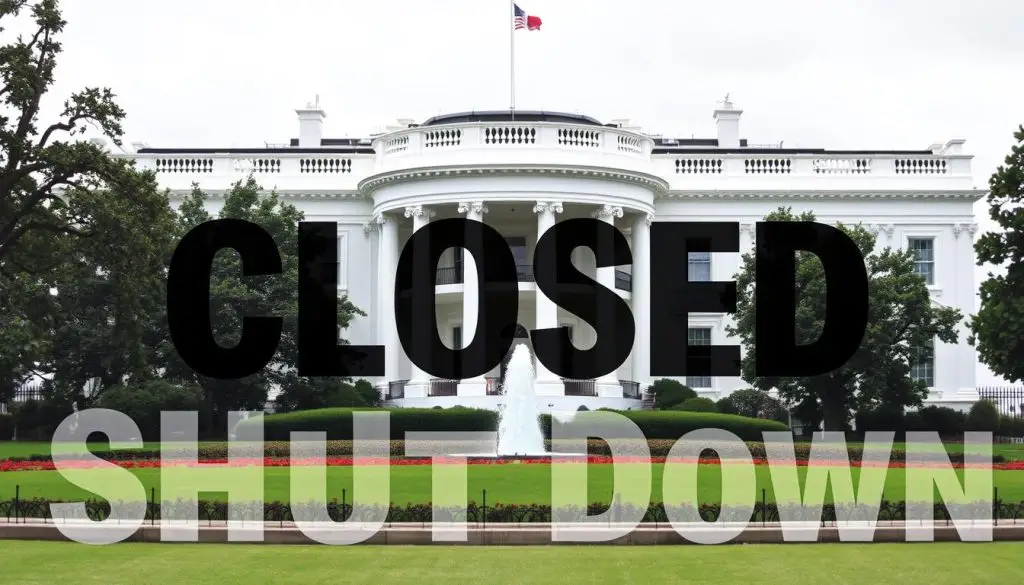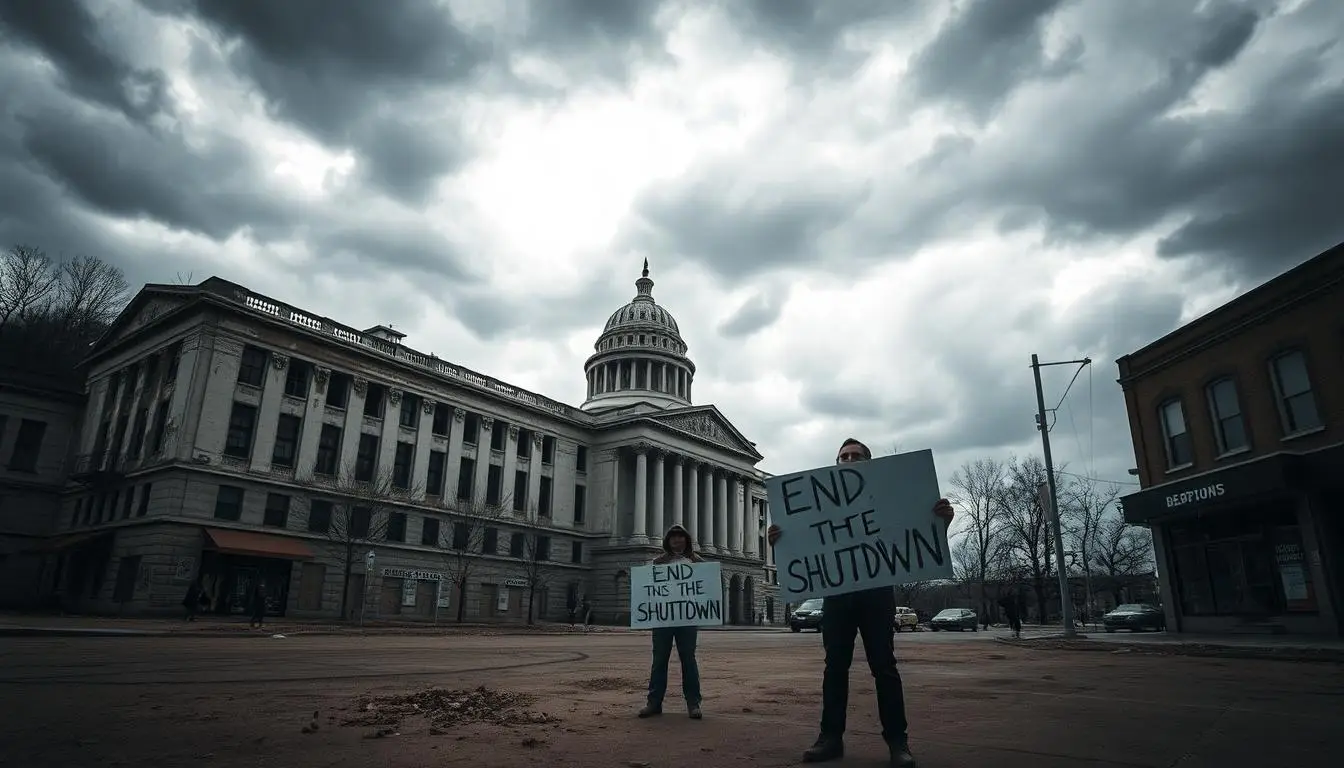Government Shutdown Nears Record Length.
As the Government Shutdown Nears Record Length, Americans face uncertainty. Stay informed on the latest developments and impacts.

Government Shutdown Nears Record Length
Click to summarize this article.
The Government Shutdown Nears Record Length, edging within a week of the longest shutdown in US history. The silence of closed offices feels loud. Paychecks are late. Families wait. I keep asking: how much strain can a country carry before patience snaps?
US government shutdown updates read like weather alerts—brief, stark, relentless. A Truth Social post from President Donald Trump cut through the fog: “THE CHOICE IS CLEAR — INITIATE THE ‘NUCLEAR OPTION.’” The phrase ricocheted across the Capitol, pulling the filibuster nuclear option into the open and putting the Senate 60-vote threshold under the harshest light yet.
That call shakes the ground beneath GOP leadership. Both parties have chipped at the rules for years, yet they’ve stopped short at the edge. Why? Because what you change today might confront you tomorrow. Even so, hints of bipartisan negotiations are starting to blink on the Hill, as if urgency itself turned the lights back on.
Meantime, the shutdown impacts are not abstract. Missed pay drives stress for air traffic controllers and TSA officers. Lines grow at LaGuardia, Newark, and Reagan National. SNAP faces legal whiplash after a court’s temporary block on suspension. Health costs loom as new ACA exchange premium rates surface for 2026, and Democrats push to extend enhanced subsidies. These aren’t headlines—they’re kitchen-table stakes, as covered in this evolving report on shutdown updates and healthcare battles.
Vice President JD Vance says the administration will likely find funds for the next military paycheck. It’s a relief, but only a partial one. We can keep patching the roof—or we can fix the storm. I look at the clock and wonder what this week will ask of us, and what we will give in return.
Government Shutdown Nears Record Length Key Takeaways
- The Government Shutdown Nears Record Length, nearing the longest shutdown in US history.
- Trump’s Truth Social post urges the filibuster nuclear option, challenging the Senate 60-vote threshold.
- Shutdown impacts intensify, with missed paychecks and flight delays at major hubs.
- SNAP faces legal twists as courts temporarily block suspension efforts.
- ACA premium changes add pressure for a deal as parties weigh costs and coverage.
- Signals of bipartisan negotiations emerge amid rising economic and human strain.
- Military pay relief is likely, according to Vice President JD Vance, but broader solutions remain unsettled.
Political Standoff Over Filibuster Intensifies as Negotiations Stir
The air on Capitol Hill is getting tighter, like a room where time ticks faster than voices. The fight over Senate rules is intense. It’s not just about rules; it’s about the kind of country we want to be.
The nuclear option filibuster is now a real option. Leaders talk about working together, but the push to change the 60-vote rule is strong. Will the gridlock break or the rules?
Trump urges the “nuclear option” to end the shutdown
Donald Trump returned from abroad and called for the nuclear option filibuster on Truth Social. He wants to end the shutdown with a simple majority vote. His message was urgent and risky.
Greg Valliere warns that this timing could upset fragile talks. I wonder: does speed solve problems or create more issues?
GOP leadership strategy faces new pressure amid Senate rules fight
With 53 seats, the GOP’s strategy is critical. They must decide whether to change the rules or stick with the status quo. The fight over Senate rules could disrupt quiet talks.
Deadlines are looming. The shutdown’s effects, like missed pay and ACA issues, are growing. See this overview of shutdown pressure points for details. Every hour without a solution adds to the pressure.
Why both parties fear eliminating the 60-vote threshold
Both sides have weakened the filibuster for nominations. But removing the 60-vote rule for bills would change the Senate’s role. Today’s majority could become tomorrow’s minority.
Veterans warn that what seems like freedom now could become a risk later. The fear is simple: power fades, but rules last.
Signals of bipartisan talks emerging on Capitol Hill
Despite the noise, talks are slowly moving forward. Democrats are using ACA deadlines to push for a broader deal. The hope is small but real.
Polls show strong views, yet the middle ground remains. Bipartisan talks are fragile but essential. They can easily be derailed by a single procedural change.
| Pressure Point | Why It Matters Now | Impact if No Deal | Political Effect | Filibuster Threshold |
|---|---|---|---|---|
| Debate over whether to eliminate 60-vote threshold for a quick vote | Faster passage but lasting precedent that reshapes Senate norms | Intensifies Senate rules fight; energizes base, risks backlash | ||
| ACA Premiums | ||||
| Expiring subsidies raise costs as open enrollment begins | Premiums may double or triple for some enrollees | Amplifies urgency in bipartisan negotiations | ||
| Public Opinion | ||||
| Voters assign blame as stalemate persists | Prolonged shutdown fatigue and economic drag | Raises pressure on GOP leadership strategy and moderates | ||
| Economic Toll | ||||
| Each week compounds lost output and missed paychecks | Billions in monthly costs and deeper service disruptions | Strengthens calls for immediate Capitol Hill talks |
Rules can end a standoff, but only relationships can end a cycle. The choice between a nuclear option filibuster and a patient bargain is not just procedural. It’s philosophical. What kind of Senate do we want when the shouting stops?
History shows that standoffs end when reality hits hard. Recent reports highlight how unified groups can block progress, even as markets remain calm. See this review of the shutdown stalemate. If a deal opens, will we walk through it together?
Government Shutdown Nears Record Length
I feel the weight in small, human ways—missed paychecks, missed signals, and a steady drumbeat of uncertainty. The shutdown is stretching on, nearing a historic mark, and it shows up in numbers and in lives. I keep asking myself: what’s the real cost when the meter never stops running?
Economic costs mount: CBO estimates $7–$14 billion hit, up to 2% off Q4 GDP
The CBO shutdown cost now reads like a ledger of lost time—$7 to $14 billion gone, with a possible GDP impact shutdown near 2% for the quarter. I picture the economy as a machine idling in a long red light. How long can we sit before the engine starts to sputter?
In the background, household stress keeps rising. I saw reporting that withdrawals and loan requests surged among federal workers, a signal of strain that feels all too familiar in moments like these. This shutdown nearing the record length is not just a headline—it’s a daily math problem for families.
Fed response: Powell says data gaps may slow decision-making
Jerome Powell data gaps tell their own story. When the gauges go dark, even the most careful driver slows down. The Fed Beige Book alternatives—industry surveys, private payrolls, and on-the-ground conversations—become flashlights in the fog.
That means caution. A softer touch on the policy wheel. I hear that and think: if the instruments are dim, decisions gain a different kind of gravity.
Travel disruptions spread amid unpaid air traffic controllers and TSA staff
Airports are where policy becomes palpable. Air traffic controller absences ripple into flight delays LaGuardia Newark Reagan, and TSA unpaid lines stretch like time itself. I can almost feel the collective sigh as departures slip into “delayed.”
Hundreds of flights stall, then thousands, while industry leaders scan the horizon for relief. The pinch travels from terminals to hotels to small cafés near the gate—each a link in a chain we forget until it breaks.
Military pay workaround likely, according to Vice President JD Vance
We look to the uniform for steadiness. JD Vance military pay assurances land like a promise in a storm, even as details remain thin. I hold that note and hope it holds.
Across Washington, meetings multiply and tempers cool, then flare again. The shutdown has entered its second month and is closing in on 35 days, a fact echoed in this record-length sweep that frames so much of the moment. Jobs, flights, savings—each day adds a notch to the tally, and we all feel it.
And yet—some impacts don’t make the spreadsheets. They sit in the long wait, the missed class trip, the plan that slips to “someday.”
Rising Human and Market Impacts: SNAP, ACA Premiums, and Agriculture
I often hear a quiet question at the grocery store: how long can families hold on? The SNAP benefits court ruling has paused the worst for now. Yet, the fear of a food stamps shutdown hangs in the air. I picture checkout lines as pressure gauges—rising, falling, never settled.
Across kitchens and food banks, the math turns personal. When budgets fray, neighbors lean on neighbors. But can charity outrun policy during an agricultural relief shutdown? The stakes feel immediate, not abstract.
SNAP at risk: court blocks suspension for now as legal battles intensify
A federal judge temporarily kept benefits flowing while arguments continue, a narrow bridge over fast water. This SNAP benefits court ruling offers breathing room, but not certainty. If the food stamps shutdown returns, demand will surge overnight, with prices high and pantries strained.
I think about scale: more than 42 million people rely on this lifeline. In one state alone, 360,000 residents depend on it each month. The averages—about $332 per household—sound small until you stretch them across an empty fridge and a long week. For more on who is affected and how eligibility works, see this snapshot of SNAP reach and household costs.
States, cities, and nonprofits mount lawsuits to protect funding
Courtrooms feel like guardrails right now. Coalitions are filing lawsuits to protect funding, arguing that approved dollars should reach families and communities as promised. I try to imagine life without that guardrail—just a sharp curve and no shoulder.
The pattern grows clearer by the week: when programs wobble, suits follow, and rulings buy time. Yet time itself is a currency that runs down. Each delay carries its own cost.
ACA exchange premium increases add urgency to a deal
On the health side, ACA premium increases 2026 show up like a warning light on the dashboard. Households browsing plans face higher prices just as belts tighten. The case for enhanced subsidies Obamacare feels less like ideology and more like rent due and medicine refills.
I read updates and feel the pressure in the margins of a family budget. The arithmetic is blunt: if coverage rises and aid stalls, people postpone care. A brief on upcoming SNAP and cost-of-living changes underlines how one policy shift can ripple through housing, internet, and work requirements.
Farmers in focus: potentially soybean purchases by China and USDA aid flows
Out in the fields, another story unfolds. Reports hint at China soybean purchases that could give growers a path through the uncertainty. If those orders land, some pressure eases; if not, markets keep flinching.
I watched news of USDA farm aid reopening after a freeze and felt cautious relief. Checks moving again can steady a season, but they do not erase the anxiety baked into an agricultural relief shutdown. For a wider view of shutdown shocks—from stalled loans to infrastructure delays—this overview of broader economic fallout shows how quickly strain spreads.
In moments like this, I ask: what keeps a community upright? Sometimes it is a court order. Sometimes a shipment. Often it is a neighbor’s hand at the door with a bag of groceries—and the hope that tomorrow’s policy meets today’s need.
Government Shutdown Nears Record Length Conclusion
How close do we let strain become normal? The Government Shutdown is nearing a record length. The CBO’s estimate of $7 to $14 billion and a 2% hit to Q4 GDP is stark. We see it in travel disruptions and gaps in data.
Even with JD Vance’s plan for military pay, it’s a thin line. The Senate filibuster debate is key. The nuclear option is tempting but risky.
There are signs of bipartisan talks. These suggest a way to move forward without rushing. Restraint can be action, and speed can be a trap.
Life at the edges is getting tighter. The SNAP court ruling helps, but it’s not enough. Food banks and ACA premiums add to the pressure.
Open USDA offices and aid offer some relief. But a funded government is essential. We need a solution that balances politics, morality, and practicality.
Let’s start with a simple plan. Pair a continuing resolution with health coverage stability. Then, we can build more. See this report on shutdown impacts for details. And for the latest on talks, check out this bipartisan negotiations update.
Government Shutdown Nears Record Length FAQ
How close is the government shutdown to breaking the U.S. record, and why does it matter?
The shutdown is just days from being the longest in U.S. history. This matters because each day adds to the economic damage and human strain. People are missing paychecks, services are delayed, and uncertainty is rising in airports, hospitals, and homes.
What did Donald Trump mean by urging the Senate to “INITIATE THE ‘NUCLEAR OPTION’”?
Trump wants Senate Republicans to drop the filibuster. This would let a funding bill pass with just a simple majority. With 53 GOP seats, this could end the shutdown quickly. But it would also change a rule that both parties have used and feared.
How does Trump’s call disrupt GOP leaders’ plans?
Trump’s call to end the filibuster throws a wrench into the plans of Republican leaders. They were trying to find a deal within Senate rules. Now, they must choose between a quick fix or a deal that might last longer.
Why have both parties hesitated to eliminate the 60-vote threshold?
Both parties are cautious because power can flip. Today’s advantage can become tomorrow’s disadvantage. They’ve already trimmed the filibuster for nominations. But making it easier for legislation risks hurting future minorities and increasing partisan fights.
Are there real signs of bipartisan talks on Capitol Hill?
Yes, there are faint but growing signs of bipartisan talks. As economic pain grows, lawmakers are starting to talk again. Reports suggest a shift in Senate posture, opening a narrow window for compromise.
What is the estimated economic cost so far?
The Congressional Budget Office estimates the cost at – billion. This could slow fourth-quarter GDP by up to 2%. The impact is real, affecting paychecks, small businesses, and local budgets.
How is the Federal Reserve responding to missing government data?
Fed Chair Jerome Powell says they’re working in the dark. After a 25-basis-point cut in October, they’ll rely on the Beige Book and private data. They might be cautious in December due to the lack of data.
What’s happening at airports like LaGuardia, Newark, and Reagan National?
Air traffic controllers and TSA officers are working without pay. Absences have surged, causing thousands of delays. This is hurting airlines, travelers, and hubs from New York to Washington.
Will military service members get paid during the shutdown?
Vice President JD Vance expects the administration to find funds for the next paycheck. This offers temporary relief. But the mechanism is unclear, and uncertainty remains if the shutdown lasts longer.
Is SNAP (food stamps) being suspended?
The Agriculture Department said it wouldn’t use contingency funds. But a federal judge temporarily blocked suspension. With one in eight Americans relying on SNAP, courts and states are racing to prevent a lapse.
What legal actions are states and nonprofits taking beyond SNAP?
Over 150 lawsuits challenge efforts to cancel or reprogram federal funds. Many plaintiffs have won temporary relief. This slows cuts while the shutdown continues.
How do ACA exchange premiums factor into negotiations?
New 2026 rates in 30 states show premiums rising. Democrats want to extend enhanced subsidies. With open enrollment starting, healthcare costs are a key bargaining chip.
What’s the outlook for farmers amid the shutdown?
China might resume buying U.S. soybeans, and USDA reopened offices to release over billion in aid. These moves can ease farm stress and shift political incentives on Capitol Hill.
How are travel and supply chains being affected?
Travel is being hit hard, with airport delays and staffing shortfalls. Transportation Secretary Sean Duffy warns of more disruptions. Cancellations and staffing shortfalls are affecting logistics, pricing, and schedules.
Why is the filibuster fight so poignant right now?
It’s a fight between speed and stability. Ending the filibuster could pass a bill with 51 votes. But it would change a Senate norm that tempers power swings. The choice could shape not just this shutdown but the next one too.
What would a negotiated compromise likely include?
A compromise might protect SNAP benefits, clarify military pay, and help airports. It could also address ACA subsidies. It would restore basic government data flows, helping the Fed and markets see clearly again.
How are ordinary families feeling the strain?
Families are feeling the strain with missed paychecks, higher grocery prices, and delayed flights. Food banks are preparing for surges if SNAP fails. The stress is daily, felt at kitchen tables and in checkout lines.
What’s the risk if leaders choose escalation over talks?
Choosing escalation could harden positions and lead to retaliation. Even if the shutdown ends fast, the Senate might be less stable. This could make future crises more likely and harder to solve without damage.
What signals should we watch in the coming days?
Look for movement on a bipartisan framework, court rulings on SNAP, and flight delay trends. Also, watch for clarity on military pay and whether Senate leaders entertain or reject the nuclear option.










